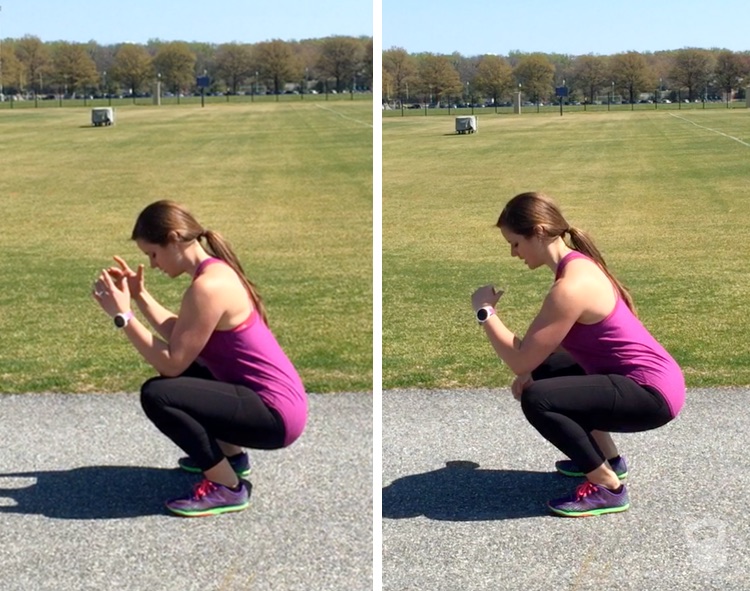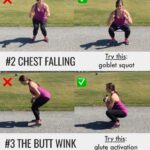This post may contain affiliate links. Please read our disclosure policy.

The squat is a basic functional movement most people perform multiple times a day. You squat when you sit down, pick things up off the floor, and in some countries, go to the bathroom! In fact, just like crawling and walking, it’s one of the first movements that comes natural to us as children.
When performed correctly, squatting with and without weight can help improve balance and core stability, strengthen the lower body, and increase mobility. Unfortunately, many people do not use proper body mechanics when squatting because aspects of our modern life decrease hip mobility. When you spend the majority of your time in flexion—or sitting—the hip flexors become tight and the glutes become weak.
To help you perform the squat injury free and with proper form, here are three common mistakes people make when performing the squat. I’ve also included exercises that will help you correct each mistakes and progressively improve the functional capacity of your body.
3 Common Squat Mistakes and How To Fix Them
Number 1: Knees Caving Inward
The most common mistake people make when doing the squat is letting their knees cave inward. While there can be multiple reasons for this, including lack of mobility and strength, a common reason this occurs is because the gluteus minimus and medius are not activating. When performing the squat, think about spreading the floor with your feet, and pushing into the outsides of your feet as you decent.
Even with proper cues, the gluteus minimus and medius, which function on the upper and lateral side of the buttocks, can be challenging to activate. While the gluteus maximus tends to get all the attention, these two muscles are incredibly important because they keep the hips and knees aligned, and play an important role in stabilizing the pelvis.
Corrective Exercise: To get the gluteus minimus and medius activating, practice performing the squat with a TheraBand tied around your knees. The band will create tension, and active your glutes as you squat. Check out my 4 Simple Moves That Will Fire Up Your Glutes for more glute activation exercises.
Number 2: Bending Forward
When performing the squat, many people bend forward as they lower their body to the ground. While this can be caused by immobility in the ankles or thoracic spine, a big reason this occurs is because of weakness and immobility in the hips. When the hip flexors are tight, which happens because we sit all day and spend most of our time in flexion, proper form can be inhibited. To perform the squat, instead of bending forward, think about sitting back into a chair.
Corrective Exercise: The goblet squat is a great mobility exercise that will help open up the hips, and reinforce proper movement patterns when squatting. To perform, simple hold a kettlebell by the horns just in front of your chest. Lower your body to the ground by shooting your hips back and down, just as if you were sitting back into a chair. Your elbows should come just inside of your knees. If possible, hold at the bottom for 10 seconds, and lightly pry your hips open with your elbows. Return to start by pushing yourself up out of the squat, focusing on driving through the hips and engaging the glutes.
To perform the squat, instead of bending forward, think about sitting back into a chair.Number 3: Butt Winking
The butt “wink” is a term used to describe the flirty movement that happens when the tailbone tucks underneath the body at the bottom of a squat. This is more formally known as a posterior pelvic tilt, and when it occurs at the bottom of a squat, it can stress the lumbar spine, and put stress on the ligaments of the SI joint.
While this can be caused by a lot of different things, to include imbalances, tightness in the hamstrings, and immobility of the hip joint, one thing you can proactively do to correct this is maintain tension in your glutes throughout the squat. Think about stabilizing your core by engaging your glutes as you lower yourself to the ground, and power through the hips as you stand without losing that tension. This will require appropriate activation of the glutes—specially, the gluteus maximus.
Corrective Exercise: The lying bent knee raise is an exercise that isolates the gluteus maximum and gets it firing. To perform, lie face down with a pillow under your lower abdomen and hips. Bend one knee to a 90 degree angle, and raise your knee off the ground and hold it for 10 seconds. Think about intentionally tightening your glutes just prior to, and during the movement. Maintain a neutral spine, and keep your hips still while performing the movement. Lower your leg back to the floor. Perform 10 reps, and repeat opposite leg.
Got any questions about how to perform the squat? Ask them below!
L





Ellen says
Love this! So informative. I know I’ve struggled with the “butt wink” and will now have homework to do!
Maria says
Hi Noelle! Great article. What can be done to be able to squat all the way down to the ground? I feel like that would help my workout squat (would it?). My ankles start coming up after a certain point lowering down. I have never been able to do it since I can remember. I think it’s an inflexibility of legs/Achilles tendon instead of a hip flexibility issue. Thank you!
Noelle says
Hi Maria! It’s hard for me to be able to give advice on what is personally going to help you, but I think your intuition about why you’re unable to get lower is spot on. If your ankles are coming off the floor, it’s often due to ankle and calf immobility. You could have help from a PT to improve mobility and strength, or work on your own at home with some mobility exercises specific to the ankle and calves. Good luck!
Abigail Lundgren says
Hey Noelle! I love your blog and your podcast with Stephanie. I have always found that my quads are more sore than my glutes from squatting. I recently started lunging with weight (versus just body weight) and my glutes were killer sore! I was surprised at this since I do BodyPump twice a week along with some crossramp and yoga. I’m thinking I’m guilty of butt winking. Would that put more work on my quads? Thanks for your great tips, I’ve got some form to work on tonight!
Noelle says
Possibly! Depending on the overall mechanics of your squat, your glutes could be entirely inactive. The hamstring can take over when the glutes are turned off, as can the low back. Try out my glute activation exercises and see how that helps!
Joelle says
Hi Noelle! So great to find your blog (via your fantastic podcast).
Love this squat post. Similar to Katy Bowman’s work. Have you read her books? I’m sort of binge reading her stuff and binge listening to your blog right now.
Thanks!
Noelle says
Hi Joelle! Great to have you here. Love Katy Bowman’s work… sounds like you’re surrounded by good people! 🙂
Mike says
I’m not sure how squats like this compare with what I was instructed to do for PT for my back problems: I start by standing with a (medicine?) ball behind my upper back with the ball against a wall. My feet are slightly in front of my shoulders, and spread about shoulder width apart. I squat until my thighs are parallel to the ground, my knees are directly over my feet (i.e., about shoulder width apparat) while holding my hands over my head with my arms straight. I hold for 20 counts & repeat 5 times.
I’ve always wondered what the difference is between doing them this way and the standard way that you’re illustrating but I never asked the therapist.
Paige says
I appreciate this article. It’s helpful to know how to do things correctly. With respect to leaning forward – the lady in the photo seems to be leaning forward. Is her hinging ok or should be be straighter?
Noelle Tarr, NTP, CPT says
Hi Paige! I’m not sure which photo you are referring to, but in the video I demo the incorrect way to do the movement, and then the correct way so you can see the difference!